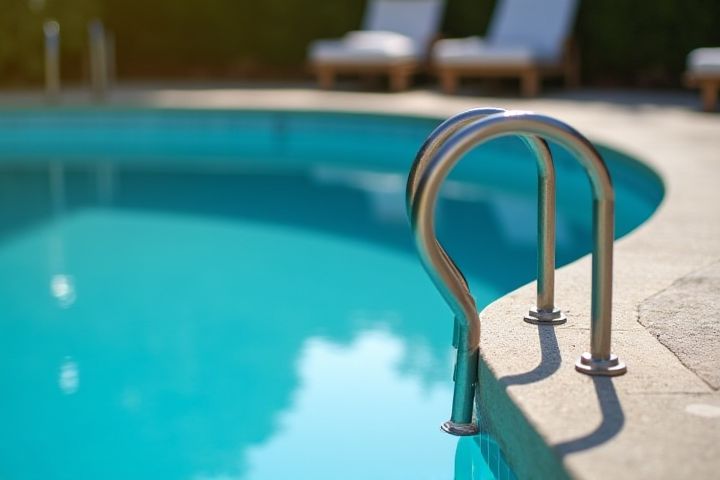
Insuring a house with a pool is possible and often involves specific considerations. Insurance providers typically assess the pool's safety features, including fencing, self-closing gates, and pool covers, which can affect your policy premiums. Your location and local regulations may also influence coverage options and requirements. Many insurers offer specialized endorsements for pools, which can protect you against liability claims related to pool accidents. It's advisable to discuss your pool's specifics with your insurance agent to ensure comprehensive coverage that meets your needs.
Can You Insure A House With A Pool
Higher Premiums
Insuring a house with a pool typically results in higher premiums due to the increased risk associated with water-related accidents. Insurance providers often consider various factors, such as the pool's size and depth, the presence of safety features like fences, and local regulations. Homeowners can expect premiums to rise by 10% to 20% compared to similar homes without a pool. To mitigate costs, consider enhancing safety measures, which may lead to discounts on your insurance policy.
Liability Coverage
Homeowners insurance for properties with a pool typically includes specific liability coverage options to protect you from potential lawsuits or claims arising from accidents. Liability coverage can start from $100,000, but many experts recommend a minimum of $300,000 to ensure adequate protection, especially considering the increased risk associated with pools. If someone gets injured while swimming in your pool, your liability coverage may help cover medical expenses and legal fees, up to your policy limits. Always review your policy to understand exclusions and seek additional endorsements if necessary for optimal coverage.
Pool Safety Requirements
When insuring a house with a pool, it's essential to comply with specific pool safety requirements that can influence your insurance coverage and costs. You must install appropriate fencing that meets local regulations, ensuring it is at least four feet high, with self-closing and self-latching gates. Additionally, having safety features such as pool covers, alarms, and signage can not only enhance safety but might also lead to discounted premiums. Your insurance provider may require proof of these safety measures to assess risk and determine the terms of your homeowner's policy effectively.
Umbrella Policy Option
Insuring a house with a pool often involves additional considerations, particularly when evaluating liability risks associated with water features. An Umbrella Policy can provide an extra layer of liability coverage beyond standard homeowners insurance, typically starting at $1 million in coverage. This option is especially beneficial for homeowners with pools, as it protects against potential lawsuits resulting from accidents or injuries occurring on the property. Ensuring adequate coverage can enhance your peace of mind and safeguard your financial assets from unforeseen incidents.
Pool Location Impact
Insuring a house with a pool can significantly depend on the pool's location. For example, a pool situated close to a fence or patio might lower liability risks, making it more favorable for insurance companies. Conversely, pools that are isolated or lack proper barriers, particularly in high-traffic areas, can lead to increased premiums or even coverage denial. Discussing these specifics with your insurance provider can help you understand how the pool's location may affect your overall premium and coverage options.
Maintenance Requirements
Insuring a house with a pool involves meeting specific maintenance requirements that can influence your policy's eligibility and premium costs. Regular maintenance of the pool, including proper chemical balancing, routine cleaning, and structural inspections, is crucial in preventing accidents and ensuring safety for residents and guests. You may need to verify that safety features like pool covers, fencing, and alarms are in place to qualify for coverage or discounts on your insurance. Failing to adhere to these maintenance guidelines could lead to claims being denied or increased rates, emphasizing the importance of diligent upkeep and compliance with local regulations.
Local Regulations
Insuring a house with a pool often requires adherence to specific local regulations, which can vary significantly from one jurisdiction to another. Many regions mandate safety features such as pool fencing, covers, or alarms to reduce liability and risk, impacting your insurance premiums. It is essential to verify your local codes, as failure to comply might result in coverage denial or increased costs. You may also need to provide documentation confirming adherence to these regulations when applying for or renewing your homeowners' insurance policy.
Coverage Limits
Insuring a house with a pool typically involves higher coverage limits due to the increased risk of accidents or injuries associated with water activities. Standard policies often have liability coverage starting at $100,000, but it is advisable to consider limits of $300,000 or more, especially if you frequently entertain guests. Property coverage for the home itself might begin around $250,000, but with a pool, it's wise to assess replacement costs that could exceed $500,000 based on local market values. Insurers might also offer umbrella policies starting at $1 million to provide additional liability protection beyond standard homeowners' insurance.
Inspection Requirement
Insuring a house with a pool often requires a thorough inspection to assess safety features and compliance with local regulations. Insurance providers typically look for specific elements, such as pool barriers, gate locks, and non-slip surfaces, to mitigate risks associated with drowning and injuries. You may need to provide documentation proving that the pool meets safety standards established by your state or municipality. Without a satisfactory inspection report, securing coverage at a reasonable rate might be challenging.
Increased Risks
Insuring a house with a pool often comes with increased risks and higher premiums due to potential accidents or liability claims. Pools can elevate the likelihood of drowning incidents, especially for unsupervised children, making liability coverage essential. Insurance companies typically require additional safety features, such as fencing or pool covers, which can mitigate risk and lower your premiums. It's crucial to review your policy carefully to ensure adequate coverage against injuries or property damage associated with your pool area.
